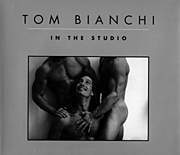
Gay/Lesbian/Feminist Bookstores Around the Country
The Mostly Unfabulous Homepage of Ethan Green
![]()


Introduction
By Tom Bianchi
In boyhood, I discovered that the leopard skin bathing suit Charles Atlas wore in his ads could be erased from the soft pulp paper of my comic books. And I learned that I could add whatever I wanted. So I did -- and do to this very day. I grew up during the argument about whether America could survive pictures of various of its citizens naked. Intuitively, I understood that they were arguing about whether or not I could exist. So I paid close attention to the discussion.
Because representations of the nude have the potential to excite us sexually, we have approached the subject with a great deal of baggage. We are tourists from a cold climate who have arrived at a warm sunny beach in overcoats and galoshes. When we look at the history of the depiction of the nude, we find that we caused the artist to be the toiler of this protective clothing. I offer this essay in the same spirit I made these pictures. I believe that the time has come for us to shed hypocrisy, take off our coats and boots, and enjoy the sun.
The invention of photography in 1839 presented an immediate threat to social mores because of its ability to depict a nude body in close proximity to our idea of reality. Since the first telling of the Garden of Eden story, we have struggled with the feelings aroused by our nakedness and the fear of our sexual energy. Suddenly, centuries of conventions invented to suppress the physiological response humans have to seeing one another naked were shattered. Western civilization had agreed that the depiction of the nude was permitted if it was sufficiently removed from fact. The farther away in time and space, the better. The Greeks left a permanent record of their nakedness in stone, which we came to accept despite our anxiety, because these works were so fine. We wrapped their nudes in what we assumed was their idealism, which permitted us to contemplate our own naked beauty.
Thereafter, in whatever age the artist was working, society demanded that the nude be referenced to as remote a time as possible. Michelangelo, by using Adam as his model, went as far back as one could, thus managing to get his sensual nudes on the wells and ceiling of the headquarters of the Church -- the most powerful suppresser of human longing for its own flesh And the queer child I was, and am, can gaze into this Sistine heaven and read the invitation Michelangelo left for me. That he still makes people nervous is evidenced by the recent debate over the cleaning of the Chapel's frescoes. Many people prefer the distance that four centuries of grimy incense smoke provided to mask the vivid vitality of our naked bodies celebrated in his paintings.
We still hear the cries of anguish generated by the first nude in a photograph -- a real son, naked just moments ago -- collapsing the protective time barrier celled Art. The history of the photographed nude is the history of photographers' efforts to adapt Art's disguises to the medium. I admit to donning these masks myself. Moreover, I have enjoyed playing with conventions of the genre and have reveled in the charade. I make this confession because, as interesting as the masks con be, we need to drop them and be naked ourselves.
The first photographs of male nudes I saw were the studio-made images of well-built men in posing straps published in the pocket-sized magazines of the 1950Ős. Those photographers adopted studio-name aliases and tailored their images to the social and legal realities of that time. The young Adonises were presented as study material for artists. Should their consumer be unable to draw a straight line, he could rely on the additional stated purpose of the picture as an example of what a man might aspire to through clean living and iron pumping. The pictures were, of course, catalogs of masturbatory opportunities. These photographers wrapped their pictures in the cover of Art to stay clear of Authority's need to suppress their probable use and, more critically the human impulse which prompted that activity. For me, these pictures were the first faint signals that, perhaps, I was not alone in the universe, that the visions in my head were connected to an outer reality.
Authority's fear of this reality was so intense, it used the equally real threats of imprisonment, chemical castration, and frontal lobotomy against photographers whose work threatened to pierce its denial. Unable to cope with the message, it lined the photographers in front of the firing squad, effectively closing many studios. Fortunately due to the tenacity of several photographer-publishers who would not bend to the neurosis of the State, a majority of our Supreme Court Justices in the 1960's decided that, henceforth, the depiction of a penis in silver nitrate on paper was not obscene, though it lacked the Art pedigree of penises rendered in marble, bronze, or paint. We have Robert Mizer, the maker of charming queer kitsch who was the Athletic Model Guild, Chuck Renslow (Kris Studio), and Clark Polak (Drum magazine), to thank for standing up to the American Morels Gestapo.
The Court, however, did not free us from the underlying rules requiring us to view the nude with sexless eyes. It merely immersed itself in on intellectually muddy debate about a concept it called "redeeming social value." The resulting rule was that the artist must provide some reason for the image to exist beyond its potential to arouse the viewer's sexual impulse. This test was doomed to fail, based as it was on the mistaken, antique, Cortesian notion that our minds and bodies were separate. The real reason that this rule was promulgated was that the judges needed an excuse for their hard-ons. They needed the artist to protect their illusion of innocence from lust -- a Herculean task inherently impossible. I found my favorite illumination of the silliness of this rule in a New Yorker cartoon some years ago. A judge looks down on a hapless defendant and informs him, "l'm sorry, but correctly numbered pages do not constitute redeeming social value.
Eventually, a sufficient number of judges learned to enjoy the connection between their brains and other organs so that the rest of us could do the same. The debate about what was art and what was pornography shifted (not completely) from the courtroom to the boardroom and beyond. I recall on inane discussion of this subject in the 1970Ős when I was practicing law at an oak-paneled firm that represented Playgirl magazine. A room full of heterosexual businessmen and lawyers poured over a pile of photographs trying to distinguish between what they labeled "tasteful tumescence" as opposed to something that would frighten the grocery store owners who sold the magazine. In those days, the editors often tried to heterosexualize the pictures by adding a female. One of the lawyers asked, "How can those guys be naked with that babe and not get a hard-on?" Recognizing a number of "those guys" from my own L.A./ Fire island hunting grounds, the child in me wanted to raise his hand -- "I know. I know." But I needed the camouflage of my three-piece uniform in those days.
In the late 1970's, I decided that the suit -- not I -- belonged in the closet. I began taking photographs in the Polaroid XS 70 format, documenting the lives of my friends at Fire island Pines. In 1980, seeking a publisher for that material, I found that the world was not quite ready for so frank a portrait of gay men. The earth would have to orbit the sun ten more times before my first book, Out of the Studio, could be published. I retreated during those years, using my camera only as a tool to develop study material for my paintings, sculpture, and drawings. I gave the world the distance it demanded.
My first black-and-white photographs were mode with a small inexpensive 35mm camera. I did not intend those pictures to either be seen as or published as photographs I have, however, included some of them in this book. In some cases, I used them to make life-size graphite drawings, which I later employed as elements in photographs intended to be seen as photographs. These images are a sort of "Photo-Putanesca" -- whatever was at hand might find its way into the picture. The photo spread at pages 22-23 is an example of this work. The image at the left is a photograph I took in 1980. In the photograph in the center, I used the drawing to represent a dream of the subject of the portrait. The photograph on the right is a portrait of the poet-artist Gavin Dillard, whose poem I subsequently superimposed over the drawing in gold leaf.
One of the greatest challenges in making the studio photograph is creating fresh meaning in a genre usually limited to the dual elements of body and seamless paper. Working within the haiku of this format can be successful, if the body or person depicted radiates a particular interest -- often beauty, celebrity, or a special humanness will do. Too often, collections of these images are no more than diversions for our short attention span -- been there -- done that -- had him -- next? Now that underwear ads ore masterworks of this art form, the time has come for artists to move on.
While I have played with the usual stock images (arms behind the neck, Gay Pose No. 5), I have attempted to expose the life in the studio beyond the polished and purely composed. For example, my Torso Belvedere, pages 74-75, has a mate. He and his mate are physically involved. Nothing succeeds better in the attempt to add life to a genre than to just let life happen. This freedom resulted in some happy aesthetic accidents. The pictures which include our cats are a case in point. Our curious cats can open doors. Sometimes they just walked in for a sniff. Sometimes they adopted on elegant rhyme with the model. Sometimes they took a part in the recreation of a myth. In the photograph, page 40, you see Bruce as Narcissus. Dickens came in and played the role of Echo, who pined away adoring the indifferent object of his devotion.
Occasionally, by providing a safe place to just let life happen, what happened was sex. Yes, Virginia, there are orgasms in the studio. From time to time over the past decade, people have complimented me for the chasteness of my work by telling me that it is not "pornography." I have been too polite to ask exactly what the offerers of this judgment mean. Are they telling me that their copy of my book has never found its way from the coffee table to the bedroom? Have I sinned (in the Arabic sense of the word) by missing the mark, aiming for the gut and hitting the head?
When an image is sexually charged, we retreat to talk about art versus pornography. Some years back, I put the following statement on the cover page of a portfolio of my erotic work:
There
is no such thing as pornography.
There are, however, bad camera angles.
If my most significant achievement in this life was to challenge the misuse of this word, I would be pleased to have this statement engraved in the granite of a headstone (which I do not plan to have). My point is simple: There is nothing in God's universe we are forbidden to see. God gave us eyes. We gave each other misapplied shame. The divine essence of our being is to see, taste, feel, experience, and know more so that we can love better.
The word pornography, which we use to condemn or assign images which are sexually explicit to a lesser rank, is both inappropriate and inadequate. The original Greek meaning of the word is "writing about prostitutes." What the word seeks to condemn is the exploitation of one person by another. In this sense, the word has utility. By misappropriating it, as we have, we found ourselves in the mental muddle which finally caused our Supreme Court to throw in the towel (or drop it) and let us look at more or less anything so long as the participants in the acts shown were consenting adults. We need a better way to evaluate the depiction of life and, more important, the way we live it. If we find a picture sexy because we believe someone in it is debased, we need therapy. If we find an image sexy because we see it as a beautiful representation of erotic play, we should say thank you.
In his advice to those who would make art, one of our finest artist-poets, Duane Michaels, has provided on insight that I consider a touchstone:
Never
try to be on artist.
Just do your work.
If it is true, it will become art.
This observation has the power to free us from the inadequacy of judgments made by assigning labels to what we see. A stir in the loins in response to an erotic image is as healthy as the calming of the heart in response to a beautiful rendering of a flower. Both can help us locate our true selves.
The art market has been a venue in which the debate continues. Robert Mapplethorpe cleverly finessed the discussion of gay sex into the bastions of High Art for the first time since athletes had a very good time with one another in classical Greek vase painting. I shall never forget seeing a middle-aged woman clad in mink at an uptown New York gallery contemplating Robert's photograph of one man pissing into another man's mouth. Mapplethorpe's strategy was to provide the critical distance art demanded by making us wince. Robert once said, "Making pictures about sex isn't sexy." I assume, given his strategy, this was true for him. Since I find the opposite to be true, my strategy has been to present sexually explicit acts as undeniably beautiful, as I find them to be in life. I know that by seeking to attract, some viewers may be confused as to what I am producing here. It doesn't matter. Just know that I am trying to narrow the gap between what we deny ourselves and what we desire.
I have also included the fact of my participation as more than an observer in some of these images. By way of a mirror, I opened the space of the picture and allowed myself in. And I had a good time in the process. Richard Avedon has said that he is invariably looking for himself in the portraits he makes. I know that this is true for me. I admit to searching for self-acceptance, to narrowing the distance between my fantasies and my experience of life, and to freeing myself from the fear of condemnation for loving what I like.
In some of the pictures, I am specific in my exploration of this fear. The pictures of Richard/Bound, pages 88-91, were originally made for a construction in which the photographs were presented together with the briefs we used and a tablet on which I wrote: I
Our
Ancestors feared the appetite of vultures for liver.
Now, a pair of Jockey shorts will do nicely.
As a child, one of the first images that charged my erotic imagination was an engraving in the Encyclopedia Britannica of Prometheus chained to the rocks. A vulture was poised overhead, ready to tear him asunder. Such was the fate the Gods imposed on him for stealing their fire. This Prometheus, as he most often is, was gorgeous. As far as I was concerned, we could lose the vulture. But I was fascinated by the fact of and beauty of ourselves as this vulnerable. In my telling of the story, no blood need be shed. We sacrificed the underwear instead. What fluid is shed is the physical result of our ecstasy -- our reward for playing the game of life -- our reward for daring to appropriate the energy of God for ourselves.
I have more than an esoteric interest in this discussion. My books are banned in a number of countries. I take some comfort knowing that, historically speaking, this fact places me in excellent company and suggests that I have something important to say. But I take greater comfort in the knowledge that Authority is inevitably impotent to suppress the beauty I see. David will remain hard long after his critics have gone flaccid.
I keep in mind, always, a lesson learned from Anna Russell's witty lectures on Wagner's Ring Cycle. Recounting the plot line's tales of incest and mayhem, she trills, "...which just goes to show you. In Grand Opera, you can talk about anything you want, as long as you SING it!" So I sing the body electric in various keys, intending to harmonize with the songs of angels I hear within myself. The lyric (thank you, Ira Gershwin) goes like this:
IT'S
VERY CLEAR / OUR LOVE IS HERE TO STAY.
Back to In the Studio
 Back
to the Stonewall Inn
Back
to the Stonewall Inn
